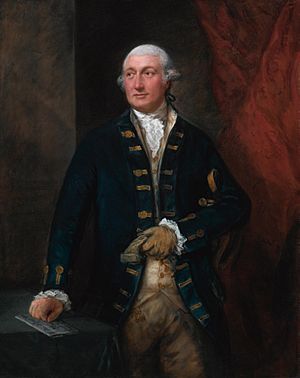Thomas Graves, 1st Baron Graves facts for kids
Quick facts for kids
Thomas Graves, 1st Baron Graves
|
|
|---|---|

Portrait by Thomas Gainsborough
|
|
| Born | 23 October 1725 Plymouth, England |
| Died | 9 February 1802 (aged 76) Devon, England |
| Allegiance | |
| Service/ |
|
| Rank | Admiral |
| Commands held | North American Station Plymouth Command |
| Battles/wars | Seven Years' War American War of Independence French Revolutionary Wars |
| Spouse(s) |
Elizabeth Williams
(m. 1771) |
| Children | Thomas |
| Relations | Alfred van der Smissen, 2nd Baron van der Smissen, his great-nephew. |
Admiral Thomas Graves, 1st Baron Graves (born October 23, 1725 – died February 9, 1802) was an important British naval officer. He served in two major conflicts: the Seven Years' War and the American War of Independence. He also held a special role as the Commodore-Governor of Newfoundland for a while.
Contents
Admiral Thomas Graves' Early Life
Thomas Graves was born in England in October 1725. He was the second son of Rear-Admiral Thomas Graves. His family lived in Thanckes, a place in Cornwall.
Graves began his naval journey around 1740. He started as a volunteer with Commodore Henry Medley's crew. By 1743, he was promoted to lieutenant. In 1755, he became a captain.
Key Moments in Military Service
Admiral Graves had a long and active career in the British Navy. He took part in many important events and battles.
Serving in the Seven Years' War
The Seven Years' War began in 1756. Early in the war, Graves faced a challenge. He was criticized for not attacking a French ship. He went through a special military trial called a court-martial and was officially reprimanded.
In 1761, Graves became the Commodore-Governor of Newfoundland. His job was to protect the fishing fleets traveling from England to the island. In 1762, he learned that French ships had captured St. John's. Graves, along with Admiral Alexander Colville and Colonel William Amherst, worked together to take the port city back.
After the Seven Years' War
After the war ended, Graves was also responsible for Labrador. French fishing fleets returned to the French Shore and St. Pierre and Miquelon. Graves made sure that the peace treaties were followed very strictly. This was so strict that the French government even complained about it. Graves' time as governor ended in 1764.
Role in the American War of Independence
Graves returned to active duty during the American War of Independence. In 1781, he became the commander of the North American Squadron. This happened when Mariot Arbuthnot went back home.
Battle of the Chesapeake
During the American Revolution, Graves' fleet fought a major battle. They were defeated by the French fleet led by the Comte de Grasse. This battle was called the Battle of the Chesapeake. It happened on September 5, 1781, near the mouth of Chesapeake Bay. This defeat was a big factor in the surrender of Lord Cornwallis at Yorktown.
Facing a Violent Storm
In September 1782, a fleet under Graves' command was caught in a terrible storm. This happened off the coast of Newfoundland. Several ships were lost, including captured French ships like Ville de Paris and HMS Glorieux. British ships like HMS Ramillies and Centaur also sank. Many merchant ships were lost too, and about 3,500 lives were lost in total. In 1786, Graves became the Commander-in-Chief at Plymouth.
French Revolutionary Wars
When the French Revolutionary Wars began, Graves was second in command. He served under Admiral Richard Howe. They achieved a big British victory over the French at the Battle of the Glorious First of June in 1794. After this victory, Graves became a full admiral. He was also given a special honor, becoming Baron Graves, of Gravesend.
Personal Life and Retirement
Lord Graves married Elizabeth Williams in 1771. They had a son named Thomas in 1775. After being injured in several battles, Graves retired in 1794. He moved to his estate in Devon. He passed away in February 1802, at the age of 76.
See also
- Governors of Newfoundland
- List of people of Newfoundland and Labrador

